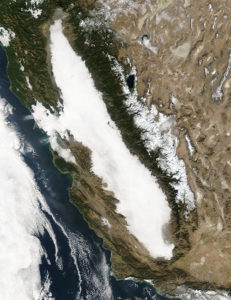The evidence seems clear: “The Central Valley’s heavy wintertime tule fog – known for snarling traffic and closing schools – has been on the decline over the past 30 years, and falling levels of air pollution are the cause, says a new study by scientists at the University of California, Berkeley,” as was explained in a UC Berkeley press release dated Apr. 10, 2019.

“The results help explain the puzzling decades-long rise and fall in the number of ‘fog days’ affecting the region, which increased 85 percent between 1930 to 1970 and then decreased 76 percent between 1980 to 2016. This up-and-down pattern follows trends in air pollution in the Valley, which rose during the first half of the century, when the region was increasingly farmed and industrialized, and then dropped off after the enactment of air pollution regulations in the 1970s,” continued Kara Manke of UC Berkeley in the “Falling levels of air pollution drove decline in California’s tule fog” press release.
So, this begs the question: When a vehicle crash occurs, for instance, and widespread wintertime fog’s been implicated as the key contributing factor, should there be a party (e.g., an individual or entity) held to account for such?
So, here’s what I’m getting at. Imagine a day, a time and a place when someone or something had been named as defendant in a lawsuit, the charge being negligence; in this case the alleged negligence stemming from the defendant’s actions, said actions leading to a significant increase in Valley air pollution, enough polluted air in this case to result in the return of Valley-based fog which in turn is determined to be a key contributing factor in, say, a freeway-based multi-vehicle pileup where sustained were injuries and/or deaths. A totally outlandish prospect or thought: You tell me?
Would such a situation arising be any different than, say, in a case whereby the user of the product glyphosate (an herbicide declared by the World Health Organization to be a probable carcinogen) where after being diagnosed with cancer then sues the product-in-question’s manufacturer, in essence, blaming them for the so-affected or so-afflicted person’s debilitating health situation? Or, different than, say, a smoker who sues the tobacco industry after having learned that they had lung cancer, in effect, implicating the tobacco industry, alleging the act of smoking itself leading to the plaintiff’s illness?
In all honestly, I hope there is never, ever a return to the day when in the Valley widespread wintertime fog factors in in a lone vehicle crash or a multiple vehicle pileup on a Valley-based freeway such as State Route 99 or Interstate 5, and air pollution has without a doubt been proven to be the catalyst behind said fog formation.
That said, the best solution is not to have the air pollution in the first place.
The reality though is that those ingredients that have in the past led to the formation of widespread (dense) wintertime Valley fog – situations of not so very long ago – could be present in the San Joaquin Valley again.
My guess is it wouldn’t take much to get back to that place. So, it behooves all of us who make the Valley our home, to take heed.
Incidentally, in California, and as it may relate, use of the chemical pesticide chlorpyrifos is now prohibited.
Image above: Jeff Schmaltz, NASA
– Alan Kandel
